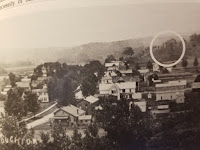 |
| site of the original "seminary" |
 |
| original location |
2. Willard J. Houghton wanted the youth of this very rural county to have an education, and he wanted them to have a Christian, holiness education. He was a farmer, perhaps with the equivalent of a third-grade education. A revival in 1851 led him to rededicate his life to God. From then on he was a Christian force to be reckoned with.
In addition to farmer, now he became a preacher and a reformer. He was grieved at the sin brought to Houghton Creek by the traffic on the Genesee Valley Canal. The main drag of town was "Jockey Street," where on Sundays they raced and bet on horses. When the Wesleyan Church building was constructed in 1876, [1] Houghton had a hand put on on the steeple to point individuals coming out of the tavern across the street to God. It gives a good sense of the piety of this man. He carried cards with Scriptures on them around with him. If he ran into any child of any color anywhere, he would stop his horse, jump off and give one to the child.
He became a lay preacher and evangelist. He often signed his letters, "yours for fixing up the world." The Wesleyan Methodist church of that day saw no division between what we would call social justice and personal holiness. It was founded against slavery. It played its part in the women's rights movement. They opposed drinking and card-playing and gambling and secret societies. And they preached personal holiness and entire sanctification. The first president of the seminary struggled with wearing a tie for several years. These issues all blurred together.
3. In 1882, Willard Houghton had seen to the rededication of a Wesleyan Methodist Church in Short Tract, not far from where he lived in Houghton Creek. While there, a denominational official put a burden on his heart to start a "first class seminary" in Western New York. The Wesleyan Methodists had started Wheaton College a few years previous, but had not given it adequate financial support and it was turned over to the Congregationalists.
 |
| ca. 1890, women, men, black, white |
Now it was time to try again. The church wanted a school "away from the cities and large towns where it would be free from the environment of evil." It would be for all students, male and female, regardless of race. The school was to be a moral "lighthouse to this dark world," a "strictly Christian school." Only firm believers in Christ "and we hope partakers of the divine nature" would teach there. And "we want to make this school one of the easiest for poor children in the county."
Houghton started raising funds in February 1883. The incorporation papers were completed in April. The charter approved by May. Ground was broken in August, 1883. The first students arrived in the almost completed building the next year in September 1884. It had a principal (W.H. Kennedy), three teachers, and 70-80 students on both the elementary and high school levels. In 1888 they added a "Bible Training Department" to the high school.
Houghton became its financial agent, traveling to raise money for the new school. He would work himself to death raising money for the school. He wrote the year the school opened, "I have lifted and lifted, runn and runn night and day until it seems to me that I shall die... Please remember me in your prayers. And pray especialy for our school work."
He would live, work, and preach another eight years, finally passing in 1896.
[1] The church stood till 1989.
Houghton started raising funds in February 1883. The incorporation papers were completed in April. The charter approved by May. Ground was broken in August, 1883. The first students arrived in the almost completed building the next year in September 1884. It had a principal (W.H. Kennedy), three teachers, and 70-80 students on both the elementary and high school levels. In 1888 they added a "Bible Training Department" to the high school.
Houghton became its financial agent, traveling to raise money for the new school. He would work himself to death raising money for the school. He wrote the year the school opened, "I have lifted and lifted, runn and runn night and day until it seems to me that I shall die... Please remember me in your prayers. And pray especialy for our school work."
He would live, work, and preach another eight years, finally passing in 1896.
[1] The church stood till 1989.






3 comments:
Thanks. Interesting.
"yours for fixing up the world"
I think I found my new email signature
A colleague of mine here at Houghton, Joe Miller, uses this at the end of his emails. I was thinking I might start using it too at some point in the future.
Post a Comment